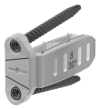Early outcomes of minimally invasive anterior longitudinal ligament release for correction of sagittal imbalance in patients with adult spinal deformity
- PMID: 23304089
- PMCID: PMC3523605
- DOI: 10.1100/2012/789698
Early outcomes of minimally invasive anterior longitudinal ligament release for correction of sagittal imbalance in patients with adult spinal deformity
Abstract
The object of this study was to evaluate a novel surgical technique in the treatment of adult degenerative scoliosis and present our early experience with the minimally invasive lateral approach for anterior longitudinal ligament release to provide lumbar lordosis and examine its impact on sagittal balance. Methods. All patients with adult spinal deformity (ASD) treated with the minimally invasive lateral retroperitoneal transpsoas interbody fusion (MIS LIF) for release of the anterior longitudinal ligament were examined. Patient demographics, clinical data, spinopelvic parameters, and outcome measures were recorded. Results. Seven patients underwent release of the anterior longitudinal ligament (ALR) to improve sagittal imbalance. All cases were split into anterior and posterior stages, with mean estimated blood loss of 125 cc and 530 cc, respectively. Average hospital stay was 8.3 days, and mean follow-up time was 9.1 months. Comparing pre- and postoperative 36'' standing X-rays, the authors discovered a mean increase in global lumbar lordosis of 24 degrees, increase in segmental lumbar lordosis of 17 degrees per level of ALL released, decrease in pelvic tilt of 7 degrees, and decrease in sagittal vertical axis of 4.9 cm. At the last followup, there was a mean improvement in VAS and ODI scores of 26.2% and 18.3%. Conclusions. In the authors' early experience, release of the anterior longitudinal ligament using the minimally invasive lateral retroperitoneal transpsoas approach may be a feasible alternative in correcting sagittal deformity.
Figures





Similar articles
-
Anterior longitudinal ligament release using the minimally invasive lateral retroperitoneal transpsoas approach: a cadaveric feasibility study and report of 4 clinical cases.J Neurosurg Spine. 2012 Dec;17(6):530-9. doi: 10.3171/2012.8.SPINE12432. Epub 2012 Sep 28. J Neurosurg Spine. 2012. PMID: 23020211
-
Early outcomes and safety of the minimally invasive, lateral retroperitoneal transpsoas approach for adult degenerative scoliosis.Neurosurg Focus. 2010 Mar;28(3):E8. doi: 10.3171/2010.1.FOCUS09282. Neurosurg Focus. 2010. PMID: 20192668
-
Comparative study of multilevel posterior interbody fusion plus anterior longitudinal ligament release versus classic multilevel posterior interbody fusion in the treatment of adult spinal deformities.J Neurosurg Spine. 2019 Apr 5;31(1):46-52. doi: 10.3171/2019.1.SPINE18754. Print 2019 Jul 1. J Neurosurg Spine. 2019. PMID: 30952136
-
Anterior Column Realignment: Adult Sagittal Deformity Treatment Through Minimally Invasive Surgery.Neurosurg Clin N Am. 2023 Oct;34(4):633-642. doi: 10.1016/j.nec.2023.06.010. Epub 2023 Jul 23. Neurosurg Clin N Am. 2023. PMID: 37718109 Review.
-
The role of minimally invasive lateral lumbar interbody fusion in sagittal balance correction and spinal deformity.Eur Spine J. 2014 Oct;23 Suppl 6:699-704. doi: 10.1007/s00586-014-3561-y. Epub 2014 Sep 13. Eur Spine J. 2014. PMID: 25217242 Review.
Cited by
-
Treatment of the Fractional Curve of Adult Scoliosis With Circumferential Minimally Invasive Surgery Versus Traditional, Open Surgery: An Analysis of Surgical Outcomes.Global Spine J. 2018 Dec;8(8):827-833. doi: 10.1177/2192568218775069. Epub 2018 May 10. Global Spine J. 2018. PMID: 30560035 Free PMC article.
-
Is circumferential minimally invasive surgery effective in the treatment of moderate adult idiopathic scoliosis?Clin Orthop Relat Res. 2014 Jun;472(6):1762-8. doi: 10.1007/s11999-014-3565-2. Clin Orthop Relat Res. 2014. PMID: 24658900 Free PMC article.
-
Combined anterior-posterior versus all-posterior approaches for adult spinal deformity correction: a matched control study.Eur Spine J. 2022 Jul;31(7):1754-1764. doi: 10.1007/s00586-022-07249-0. Epub 2022 May 27. Eur Spine J. 2022. PMID: 35622154
-
Limitations and complications of minimally invasive spinal surgery in adult deformity.Ann Transl Med. 2018 Mar;6(6):109. doi: 10.21037/atm.2018.01.29. Ann Transl Med. 2018. PMID: 29707558 Free PMC article.
-
Role of minimally invasive surgery for adult spinal deformity in preventing complications.Curr Rev Musculoskelet Med. 2016 Sep;9(3):309-15. doi: 10.1007/s12178-016-9355-6. Curr Rev Musculoskelet Med. 2016. PMID: 27411527 Free PMC article. Review.
References
-
- Ames CP, Smith JS, Scheer JK, et al. Impact of spinopelvic alignment on decision making in deformity surgery in adults. Journal of Neurosurgery Spine. 2012;16(6):547–564. - PubMed
-
- Kim YB, Lenke LG, Kim YJ, Kim YW, Bridwell KH, Stobbs G. Surgical treatment of adult scoliosis: is anterior apical release and fusion necessary for the lumbar curve? Spine. 2008;33(10):1125–1132. - PubMed
-
- Michael MA, Loughenbury MP, Rao MA, Dunsmuir MR, Millner MP. A survey of current controversies in scoliosis surgery in the United Kingdom. Spine. 1976;37(18):1573–1578. - PubMed
-
- Schwab F, Patel A, Ungar B, Farcy JP, Lafage V. Adult spinal deformity-postoperative standing imbalance: how much can you tolerate? An overview of key parameters in assessing alignment and planning corrective surgery. Spine. 2010;35(25):2224–2231. - PubMed
-
- Wollowick AL, Glassman SD, Perra JH, Schwab FJ. Patient evaluation and clinical assessment of adult spinal deformity. Instructional Course Lectures. 2012;61:469–479. - PubMed
Publication types
MeSH terms
LinkOut - more resources
Full Text Sources
Medical
Miscellaneous

